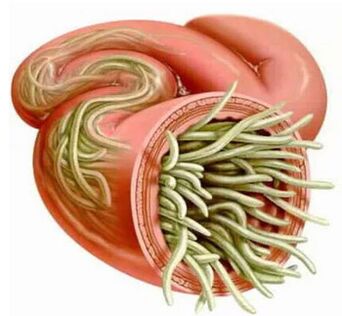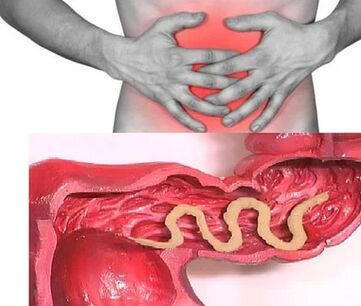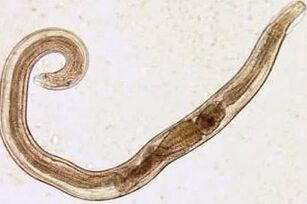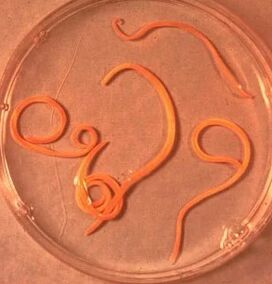So far, science is known about 280 types of worms that can grow and live in the human body, parasites in different organs and tissues.The frequency of infections in people depends on the climatic and socio -economic conditions of specific territories (in underdeveloped countries, especially in countries located in tropical and subtropical regions, the level of parasitic infection is much higher than economic development states).
Method of human infection with helminths:
- Biogelmintosis (Animal infection).
- Helminthoses Contagioine (transmitted from one person to another).
- Geogelmintoses (the disease caused by parasites conducts one of the important wonders on Earth).

Factors affecting the manifestations of helminths
Methods of penetration of parasites into the body:
- The level of helminth's adaptation to the human body;
- The density of the population (quantity) of the parasitic individuals;
- The deep living environment (parasites live in the thickness of soft tissues, and clearing in voids of empty organs).Some helminths in different stages have a form of education and fabric.The larval and developing stages of worms, as a rule, causes more obvious pathological changes.
In the absence of infection, the number of mature parasites in the human body does not increase.This feature significantly distinguishes the Heelminthic invasion from diseases caused by bacteria, viruses, fungi and simple organisms.
Worms in humans: Symptoms
Helminthosis is a disease characterized by two stages of the course (acute, from two weeks to two months) and chronic (from a few months to several years).
Symptoms of acute phase of worm disease
The first signs of the disease can manifest in different times (usually after 2-3 weeks, with Ascaridosis-Sau 2-3 days and with phylairiosis, the incubation period can last 6-18 months).
In the acute phase of parasitic invasion, the most typical symptom is an allergic reaction (antibodies generated from antigens of migration larvae of parasites).Typically, itchy rashes, easily recurrent courses, increased in the recurrence process, the lymph nodes of the area appear on the skin and the appearance of general or appropriate edema, muscle pain and joints may occur.In addition, the parasitic migration larvae can cause pain in the chest, cough, suffocation, stool disorders, nausea and vomiting.
At the same time, the acute phase of helminths can be accompanied by more serious disorders (severe pneumonia, hepatitis, allergic myocarditis, hepatosterogalia (liver and spleen).
In the blood, the amount of eosinophilia (eosinophilia) increases and the normal quantitative ratio between protein fractions (blood pressure disorders) is disturbed.

Signs of chronic helminth disease
Symptoms of the chronic phase depend directly on which organs are crowded with parasites, as well as their size and quantity play an important role.
Therefore, when parasites in the intestines of single people, the disease may occur without symptoms (except for cases of infection with a huge parasitic).The characteristic characteristics of the chronic phase of helminths are disorders.In children, acenoarotic syndrome and more obvious pain.With Ascarides encroaching, obstructing intestinal tract, jaundice and pancreatitis are possible.
By consuming all the essential substances for their important activity from the host body, helminths cause digestive disorders, violate the absorption of vitamins, minerals, carbohydrates, proteins and fat.At the same time, the products of the life of worms inhibit normal intestinal microflora and reduce the body's immunosuppressure.
In people with helminths, due to weakened immunity and enhanced cell division (the consequences of the continuous recovery of tissue parasites), the risk of malignant tumor increases significantly.
Types of parasitic helminths in the human body
The cause of helminths in humans are two types of worms: round (nematodes) and flat (ribbon and disc).
Roundworms
Worms
Parasites are the cause of enterobiosis is the thin cavity worm (up to 10 mm) with gray -white dyeing.Infections occur in a confusing manner (through the mouth).The reason for this is filthy hands.The eggs of the parasite may be in the ground, on the wool of infected animals, vegetables and unnamed fruits, etc.The at the same time, with enterobobiosis, cases of self -expansion (especially in children) occur due to the results and the egg swallowing is not uncommon.The cutting larvae grow within two weeks in the digestive tract.Turns into an adult individual, the parasitic worm in the lower parts of the small and top parts of the colon.

Askarida
Askaride is a large type of parasite that has a red-shaped red form, reaching a state of maturity of 40 cm (female) and 15-25 cm (male).There is no suction cup or other repair devices, Ascaride can independently move towards the food mass.Eggs are placed by female parasites distinguished from feces.
Institutions of the Academy occur in the case of mature swallow with water or vegetables and fruits that have not been washed but have soil seeds.After the egg penetrates the intestines, the larvae are ripe out of them.Then, introduced into the intestinal wall, they reached the heart according to blood flow, and from there they fell into the lungs.Through the lung alveoli, the larvae of Ascarida through the respiratory tract enters the oral cavity again.After many swallowing, parasites reached the small intestine, where it developed into an adult.The worm lives for 12 months, then dies and stands out from the feces.In the intestines of a owner can live one or several hundred individuals.
Vlashev
Vlasov, the cause of Trichocephalosis, is a parasitic white helminth in the original part of the large intestine and reaches a size of 4-5 cm.The parasite is fed with blood and tissues of the rectal mucosa.
The sobbing eggs are placed by the female on the walls of the intestine that appears with stool.Their development occurs in the environment (optimal in soil).Eggs with parasitic larvae are penetrated into the body with a way of meat, through dirty hands, with water or vegetables and fruits that have not been exploited.

Trichinella
Trichinellosis's pathogens are a small round helmet that reaches a length of 2-5 mm.Infections occur when using poor fried meat (pork, bear, wild boar).The exam penetrates the intestine and parasitic larvae for 3-4 days to nine to the state of sexual adult individuals.The life expectancy of the worm is 40 days, then the parasite die.Promoting the intestinal wall, larvae into the blood and being carried in all organs of the human body, settling down in the muscles.In this case, the respiratory muscles and faces, as well as the muscles of the limbs, are often the most affected.
In the first days after the invasion, the patient complained about abdominal pain.Then, after about 2 weeks, the body temperature increased to 39-40 seconds, the itchy rash appeared on the skin, muscle aches grow and the face swelled.During this period, in the case of large infection, there is a significant risk of death.After about a month, recovery occurs.The parasite is encapsulated in a spiral shape, then it dies for two years.
Unkylostoma and Non -Core
These two parasites are similar by biological characteristics, as well as in diseases.With this, it is usually consolidated them under the common name (ankylostoma).Worms reaching a length of 10-15 mm are parasitic in 12-P.intestine.It should be noted that this is one of the most common, but at the same time, rarely identified parasites.The worms enter the human body through the skin when exposed to infected soil.Moreover, falling into blood, they, like ascarides, migrated to the lungs, and then, through the bronchus, along with the sputum dance - to the digestive tract.Anquilostoma parasitic in the intestine, attached to the intestinal wall.An exclusive parasite with blood biting blood vessels penetrates mucous membranes, an anti -detection component there.During the day, an adult can absorb 0.05-0.35 ml of blood.Therefore, the most typical symptom of this helminth is iron deficiency anemia, as well as changing the ratio of protein number (blood pressure disorders).
Flat worms
Broadband
This is one of the largest helminths reaching a length of 10-20 meters.The disease caused by this parasite is called dipillobotriosis.The deep development cycle begins with freshwater fish or crustaceans.The larvae enter the human body, the last owner of a broadband ribbon with an acne fillet or infected.Approaching the small intestine, parasites are attached to its walls and for 20-25 days of development into an adult individual.
Hepatic bacon
A parasite that causes Opisthorchic stones is a flat worm with a length of 7-20 mm.It should be noted that more than 50% of cases of infection with the liver plate (it is also known as Bicony CAT) falls into Russian residents.The parasitic larvae began to grow after the egg fell into fresh water (from swallowing snails).After that, they enter the body of the fish (carp, carp, carp, brick, roach).Infections in humans occur when you eat infected fish meat that has not undergo enough thermal treatment.The larvae of the liver bomb from the small intestine penetrate into the bile ducts and into the gallbladder, fixed there with two suction cups.
Bull and pork
These parasites are almost identical to the structure of 5-6 meters long.Infections of Thasiarinhosis and Tusia occur due to the use of Finnish -contaminated cattle or pork (one of the intermediaries of helminths).Finnish people can see, presented in the form of white bubbles, reaching a 0.5 cm size, attached to one person's small intestine and for 3 months turning into an adult.The parasite of the band, including more than 2000 segments, continuously develops.At the same time, the last segments contain eggs and independently move along the colon to the anus open hole, then crawl out of the anus, or stand out into the outside environment with the feces.The most typical symptoms of helminths are gastrointestinal violations.
Echinococcus
For this parasite, one is an intermediary host.The parasitic worm in the human body is in the form of Finns.The last owner of Echinococcus is a wolf, a dog or a cat.The infection occurs in a way that is exposed to animals and environmental objects, with a small number of Echinococcus eggs.After entering the intestine, oncosphores (six -black larvae) develop from them.From the intestine, they enter the blood and are carried throughout the body.
Alveokokk
This parasite, considered to be a series of ecinococcus, is the cause of one of the most dangerous Helminthiases (aleococcosis), similar to the severity of cirrhosis and liver cancer.The infection occurs with the invasion of oncosphere (eggs with ripe larvae) into the intestine.There, the embryo out of the egg and, introduced into the intestinal walls, invading the blood.Moreover, with blood flow, parasites spread through all tissues and organs of the body (most often positioned in the liver).It was the main development stage that began in the larvae (a multi -level bubble, Laurelocyst).Each chamber contains a embryo end of the parasite, continuing to grow gradually.Lavrocists are very positive forms that continuously develop due to increased bubbles, as well as capable of germinating into the liver, such as metastatic cancer.
Diagnosis of helminths
Diagnosis of Helminthic invasion includes the following events:
- A thorough collection of an Anamnesis helps find possible causes of infection;
- Studies in the laboratory of stool, blood, content of the intestine 12p, rectal mucus and around the anus, muscle tissue, lung sputum, bile.During analysis, eggs, segments or parasitic pieces may be detected.At the same time, the content of hypernage in the blood is also a signal of the presence of helminths.
- In the diagnosis of diseases caused by larvae or tissue parasites, seral research (Elisu, RSC, indirect convergence, fluorescent immunosuppressant analysis, etc.) are carried out.
- To identify helminths that affect liver tissue, ultrasound, CT and endoscopic studies are prescribed.
Worms in humans: Treatment
During the acute phase of parasitic infections, patients are prescribed for detoxification and sensitivity.In a serious process of disease (liver worm disease, trichinello), glucocorticoids are used as medical indications.
Are drugs of specific therapy, taking into account the nature of pathogens, special chemotherapy agents are prescribed.
In parallel, patients are recommended to use antihistamine and absorbent.The final stage of treatment includes the use of normal microbiological microbiology.
A special diet is also prescribed (food should be easy to digest and contain low fat).
During Anthelmintic therapy, patients need to strictly follow personal hygiene (to avoid re -infection).At the same time, with many helminth diseases, all family members and infected people are constantly related to treatment.























